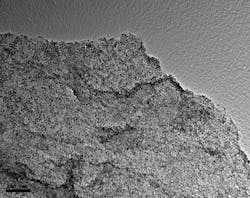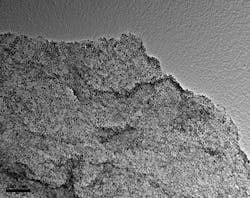Eco-Friendly Ethylene Production Beckons
A composite catalyst consisting of nitrogen-rich graphene and copper nanoparticles has the potential to efficiently and selectively convert carbon dioxide to ethylene, say researchers at Brown University, Providence, R.I. If excess carbon dioxide can be converted to ethylene, it could help make the chemical industry more sustainable and eco-friendly, they add.
Figure 1. Nitrogen-rich graphene festooned with finely tuned copper nanoparticles selectively converts carbon dioxide to ethylene. Source: Sun Lab/Brown University.
“We hope that this new catalyst could be a step toward a greener way to produce ethylene,” notes Shouheng Sun, a professor of chemistry and engineering at Brown, whose research team developed the catalyst.
Qing Li, a former postdoctoral fellow in Sun’s lab and now a professor at Huazhong University of Science and Technology in China, suggested experimenting with copper nanoparticles deposited on several different graphene surfaces. Their findings, published in Nano Energy, showed that 7-nm copper particles placed on graphene doped with pyridinic nitrogen achieved 79% selectivity for ethylene, significantly higher than other approaches.
[javascriptSnippet ]
“Our experiments indicate that the presence of pyridinic nitrogen in the graphene network may help to anchor the Cu nanoparticles down and to attract more CO2/protons to the Cu proximity to facilitate the reaction. The reaction is likely controlled by the synergistic effect between the doped graphene and Cu nanoparticles, reaching higher selectivity to ethylene than other catalysts reported. With this in mind, we may develop other metal nanoparticles/N-doped graphene composite catalysts with high activity and selectivity for a specific hydrocarbon product,” says Sun.
“The 79% selectivity is obtained from the ratio of Faradaic efficiency towards ethylene over the efficiency towards all hydrocarbon products, indicating good selectivity towards ethylene. However, the catalytic activity towards hydrocarbons is still not high, and hydrogen evolution reaction dominates the reduction reaction. We need to increase the catalytic activity but to maintain high ethylene selectivity,” he adds.
Thus, the next step is to look for factors that would spur high ethylene selectivity. “Once the factors are identified, we should be able to optimize the synthesis to prepare a composite catalyst with high activity/selectivity for the electrochemical reduction of CO2 to ethylene,” Sun believes. The researchers are focusing on C-C coupling hydrocarbon products, but may also tune the catalysis to alcohols.
One important aspect of their ongoing research is to use the high quality nanoparticles to help understand the reaction mechanism, the researchers note. “With these high quality nanoparticles, surface active sites may be identified and nanoparticle catalysis may be further tuned to optimization,” explains Sun.
“There is much more work to be done to bring such a process to an industrial scale, but this is a start…. Although our synthesis is in lab-scale, the process can be scaled up once the catalytic properties are tuned and optimized,” he adds.
The team also plans to use the new catalyst in tandem with other catalysts to produce different reaction products, and analyze the robustness of the catalyst and its susceptibility to poisoning. “Over reaction time, nanoparticles will be checked by TEM [transmission electron microscopy], X-ray diffraction, and electrochemical properties to monitor the changes of their morphology, structure and redox behaviors,” says Sun. “Our catalyst is stable against the typical CO poisoning, but not so against oxygen that can oxidize Cu to Cu2O or CuO, lower the catalytic activity,” he notes.

